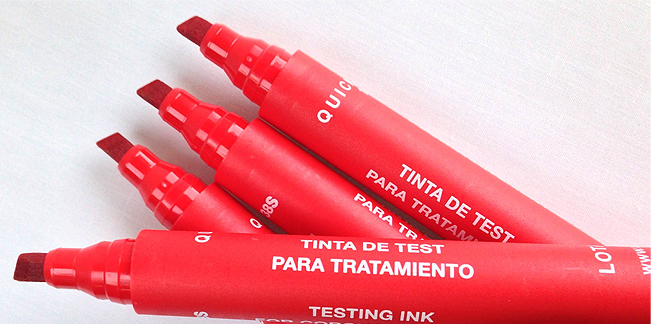QUICKTEST 38®S PEN
Quicktest 38®S Poly Testpen serves to check if the treatment of polyolefins (polypropylene, polyethylene, polybutylene) has shown an effect on the material. A stroke of the pen leaves a full line on the material if the material’s surface energy has a value of ca. 38 dyne/cm (mN/m) or more. If, however, the surface energy is lower than ca. 38 dyne/cm (mN/m), then the fluid contained in the pen will form small droplets on the surface.
The marker represents good readability by a striking red color.
The fluid applied to the surface will dry within seconds, it does not need to / cannot be wiped off anymore.
- Extremely easy to handle
- Perfect for quick spot checks on polyolefins
- No wiping off necessary, lasting display of result
- A quick GO / NO-GO solution

ATTENTION: The test fluid of the Quicktest 38®SPoly Test Pen contains solvent. This might cause wrong results being displayed on materials or surface coatings not being solvent resistant!
EXAMINATION OF POLYMER PLASTIC PRETREATMENT
To make possible the printing and adherence of polymer plastics it is inherent that the surface be treated, so that the surface tension rises to a defined point.
Untreated PE and PP have a surface tension of about 30 dynes/cm. Well treated PE and PP should have a value of about 38-41 dynes/cm for printing.
Polymer plastics with a surface tension of less than 37 dynes/cm have binding difficulties. This is recognized in that the tape pull-off test has a negative result.
Swipe the felt tipped Quicktest pen 38®S across the surface to be tested. A GO / No-go result will show. If the ink bubbles or breaks up as shown in the figure to the right, the surface tension is too low. If the ink sheets out, it has about a 38 dyne/cm surface tension or higher and should be good to go for printing adhesion.
This test pen is designed for personnel in routine testing purposes. It can give one a good insight of whether the material is being treated enough or not.
The testing inks evaporate quickly when the test pens are not kept closed. Therefore, immediate closure of the pens must take place after use. (The cap will “click” when properly closed.)
The surface tension is a definite criterion for the adhesion of printing ink onto PE and PP. Other factors exist such as exudation of lubricants that influence the adhesion of inks quite negatively, that in turn, do not necessarily register on surface tension testing. Consequently, even though good surface tension results were found, the printing ink adhesion can result negatively.
It is also possible, that polymer plastics with the same surface tension can give completely different printing ink adhesion results. In most cases, however, one can disregard these exceptions and get best possible results of printing ink adhesion with surface tensions of 38-41 dynes/cm. A surface tension value that is too low, approximately 34 dynes/cm, results nearly always in bad adhesion.
Call 920.465.6678
BUY NOW
Questions?
Do you have a question, comment, or suggestion?
We want YOUR input!



